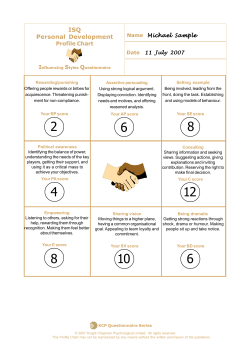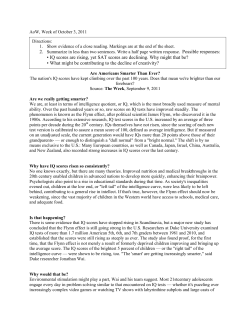
Standard Teamer
A Customized Report for: Team CentACS Date: June 04, 2015 Standard Teamer ©2009 CentACS, LLC. ALL RIGHTS RESERVED.. A Customized Report for: Team CentACS Date: June 04, 2015 Workplace Big Five Profile™ 4.0 Norm Group: U.S. Standard Teamer Segment Name An Overview of Your Report Distribution of Supertrait Scores with Narrative Interpretation Distribution of Subtrait Scores with Narrative Interpretation Table of Individual Trait Scores Overall Team Mix-Homogeneity versus Heterogeneity Chart of Team Names for Supertrait Distribution Chart of Team Names for Subtrait Distribution Capacity for Strategic and Tactical Thinking Comfort with and Appreciation for Diversity Conflict Proneness Energy Level Innovation versus Efficiency Leadership within the Team - Kotter's 13 Leadership Factors The SEA Model Meredith Belbin's Nine Team Roles Lencioni's Five Dysfunctions of Teams McIntosh-Fletcher's Six Elements Tuckman's Four Stages of Team Formation CentACS' Competencies-Individual and Team Means Resources for Teams How To Use This Report About Center for Applied Cognitive Studies Page 1 4 6 12 13 14 15 20 23 26 30 32 35 38 41 44 47 50 53 54 55 57 Note 1: In this report, when we analyze models developed elsewhere than CentACS (such as the Lencioni), we are assessing the degree to which one’s WorkPlace Big Five Profile scores would tend to provide natural energy for those models, based upon published definitions of the terms used in the models, research and/or logic. The scores contained in this report are only estimates of how one might score on the various models based upon WorkPlace scores. Please note that actual behaviors at work might vary from the estimates for some individuals. Note 2: If anyone in this Teamer Report had a WorkPlace Report scored using a norm group other than the one designated in the header of this Teamer Report, then their WorkPlace has been rescored using the norm group above. The norm group in the Header was designated for the original project. For comparison purposes on a team report, everyone should be scored using the same norm group. Note 3: The date on this group report reflects the date that this report was run. The individual dates on which the participants completed their WorkPlace assessments are available upon request. © 2010 CENTER FOR APPLIED COGNITIVE STUDIES. ALL RIGHTS RESERVED. A Customized Report for: Team CentACS Date: June 04, 2015 Workplace Big Five Profile™ 4.0 Norm Group: U.S. Note: The bullets below represent brief interpretations of your scores on each of the major sections of this report. For more detail in support of a specific interpretation, go to the section indicated in the title box just above it. Capacity for Strategic and Tactical Thinking "Your team has low average scores on both Extraversion and Originality. This suggests that the team has abundant energy for engaging in the demands of tactical implementation, and likely finds strategic thinking, analysis, and planning to be unproductive and tiring." Comfort with and Appreciation for Diversity "Your team averages low across all six traits, suggesting that the team has abundant energy for handling a high degree of homogeneity. In fact, the team, as a whole, is likely uncomfortable with diversity, and will attempt to eliminate or modify others' differences in order to feel comfortable." Conflict Proneness "Your team contains no one scoring low on N, which suggests that your team always shows emotion when in conflict, and that it needs to get such feelings expressed before being able to engage in problem solving. Everyone on your team scores in the middle area on N, which means that the overt expression of emotion during conflict will be situational. When all appears quiet during a disagreement, be sure to check with all members to insure that unexpressed feelings get on the table. Your team contains no one scoring high on N, which suggests that your team seldom shows emotion when in conflict. Make it a standard practice to check members' feelings before problem solving, in order that their opinions can guide problem solving. Doublecheck members' possible reservations, as you have no high Ns, who tend to be the 'conscience of the team.'" "All of your team scores low on E, which suggests that members typically hold in opinions and feelings during conflict. Be careful that the opinions of all are expressed before beginning problem solving. If you don't know what the lower Es are thinking, it is typically because you haven't asked them. Your team contains no one scoring in the middle range of E, which suggests that your team is comprised of extremes--either extremely expressive during conflict, or holding opinions and feelings in during conflict, or both. Your team contains no one scoring high on E, which suggests that your team is seldom highly expressive or talkative during conflict. Make it a standard practice to check with members before problem solving, in order that their opinions can guide problem solving." "A majority of your team scores low on O, which suggests that, when your team is in conflict, there is a stronger tendency to protect the status quo than there is to try new approaches. Do not reject new ideas outright, but evaluate them responsibly. A majority of your team score in the middle area on O, which suggests that the tendency towards new ideas, as opposed to preserving the status quo, during conflict will be situational. Your team contains no one scoring high on O, which suggests that your team is seldom innovative when in conflict. When experiencing conflict, make it a standard practice to explicitly ask members for new approaches, as well as possibly asking an outsider for suggestions." "A majority of your team scores low on A, such that conflicts will involve mostly strong challengers, with adapters and negotiators in the minority. As a result, conflicts may be resolved to the detriment of the minority adapters--be sure to encourage all members to air their personal points of view on the issue as a part of the conflict resolution process. A majority of your team score in the middle area on A, which suggests that most team members have a ''win-win'' outlook and are able to keep all team members' points of view in mind. Your team contains no one scoring high on A, which suggests that your team has no members who are averse to conflict and disagreement. As a result, conflict situations can be highly argumentative. An outside facilitator could help, as well as designating any team members who score mid-range on A to facilitate." "A majority of your team scores low on C, which suggests that your team has relatively few members who are focused, organized, and methodical when experiencing conflict. As a result, and because of the dominant tendency to be spontaneous and diffused in focus, conflict situations can end up being volatile, protracted, pg or 1 ©2009 CentACS, LLC. ALL RIGHTS RESERVED.. even unresolved, unless the team puts itself in the hands of a disciplined facilitator. A majority of your team score in the middle area on C, which suggests that your team has both extreme tendencies of spontaneity and discipline represented in a conflict situation. If in fact, either high Cs or low Cs are missing from your
© Copyright 2025










